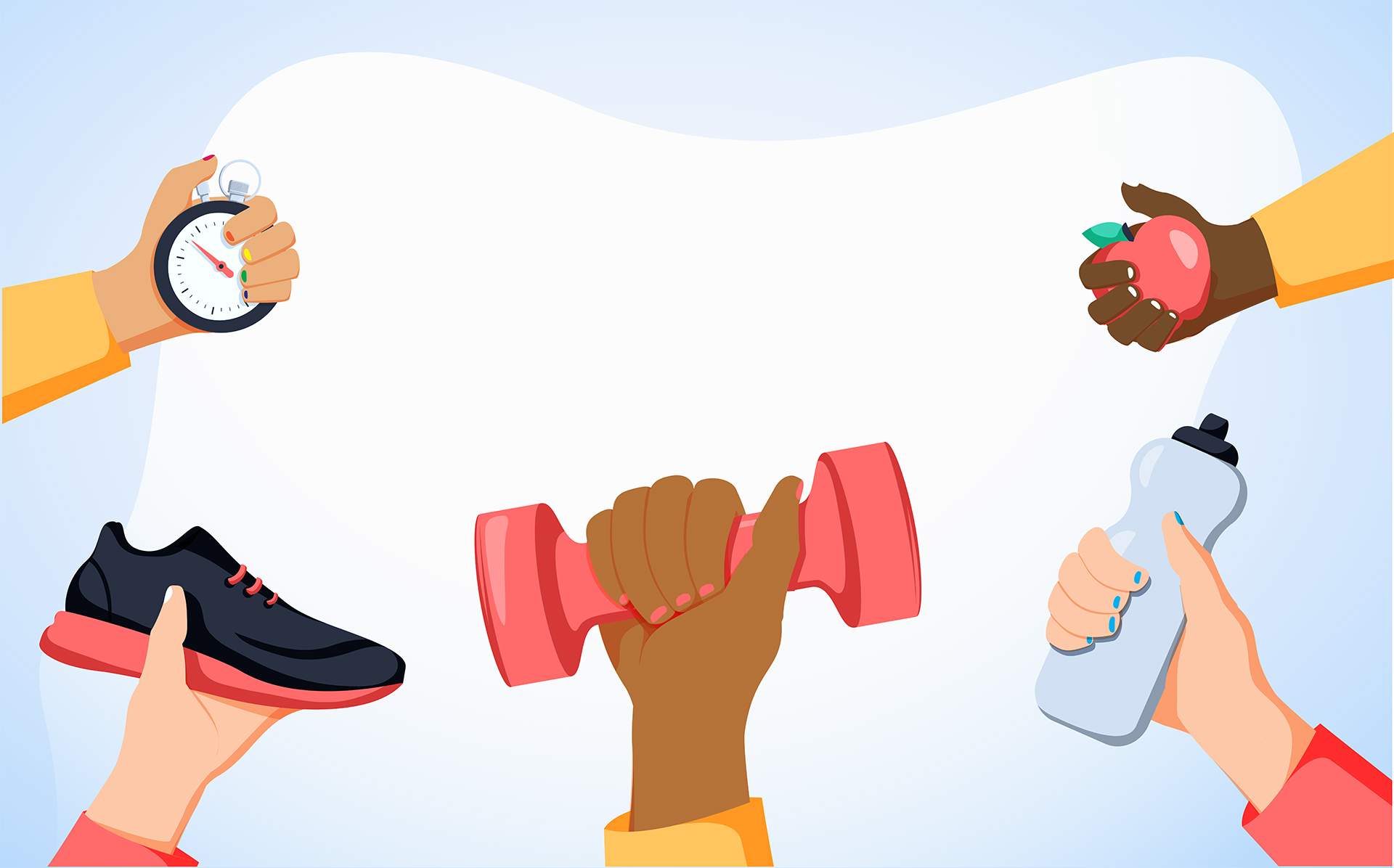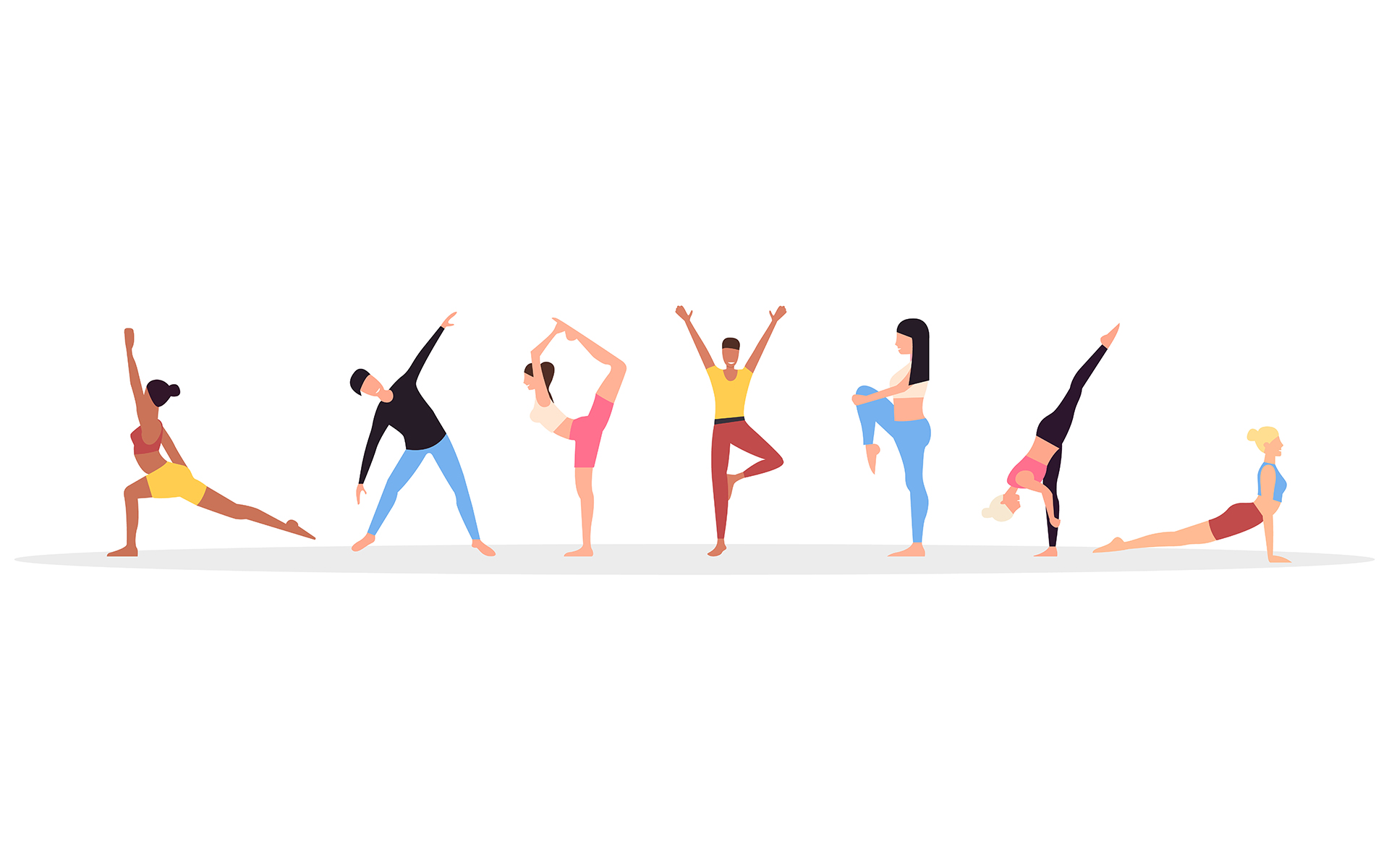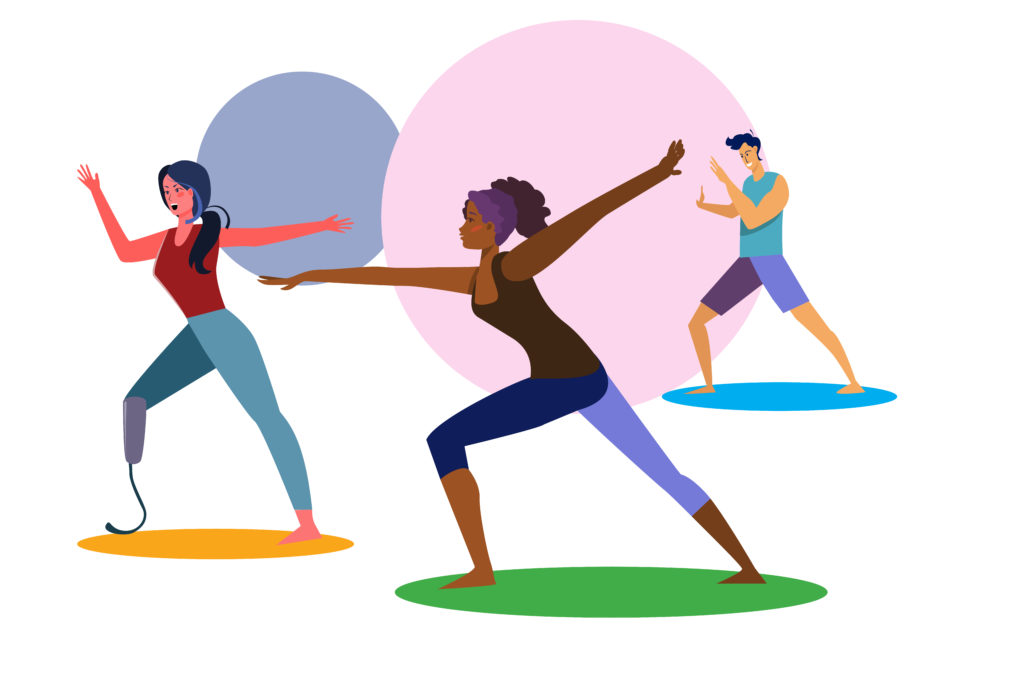
Mindful movement allows us to check in with our bodies and get moving in a way that can help us lower stress, release stagnant energy, and strengthen our mind-body connection. It’s a great way to practice self-care by incorporating both mental and physical well-being. Oftentimes, when we engage in mindful movement to help our body feel better, our mood is uplifted, too.
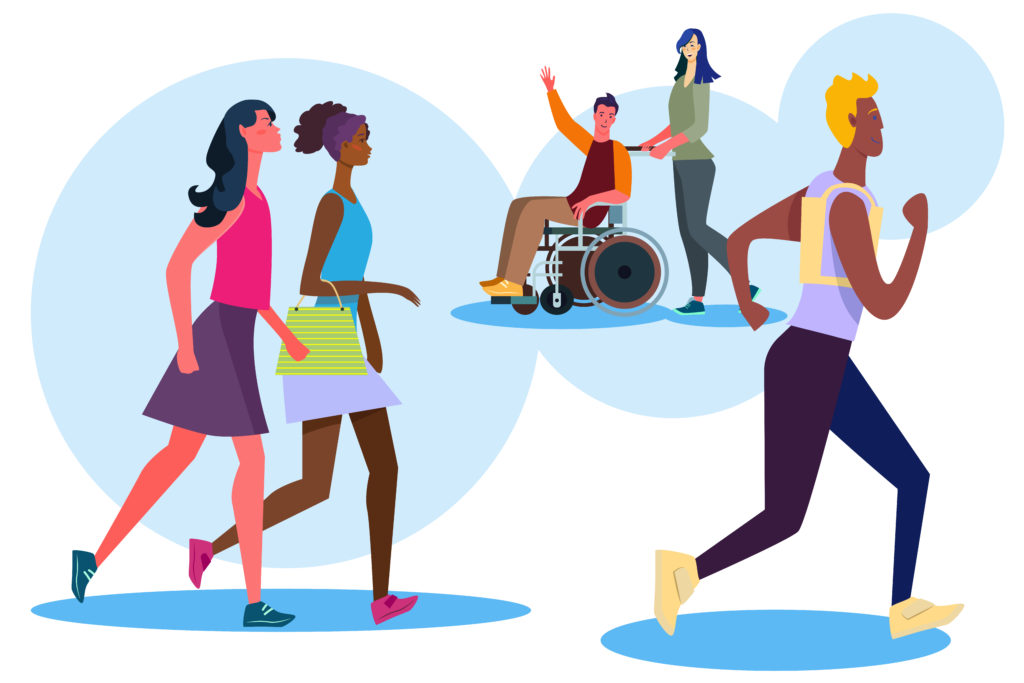
What is Mindful Movement?
The principles of mindful movement are the same as any other mindfulness practice. We aim to bring our full attention to the present moment to experience the here and now. We bring our awareness to our movement and focus on our breath or the way our body feels as it moves. When our mind wanders, we bring our attention back to the practice, to our breath, to our body.
4 Types of Mindful Movement
- Breathing exercises are different from when we observe our breath at rest during seated meditation. Instead, we connect with our body by purposefully elongating our breaths to calm our parasympathetic nervous system, or shorten our breaths for short periods of time to refresh and refocus.
- A walking meditation can be a simple and effective way to explore mindful movement. The biggest difference between a walking meditation and going for a walk as we usually would is that when we’re practicing meditation, we aren’t aiming to go anywhere. Instead, we walk slowly and try to bring our full awareness to the act of walking. That can look like focusing on our breath, or feeling the ground beneath our feet as one step turns into the next. When our mind wanders, we bring it back to the sensations of the moment.
- Stretching and yoga can help us release tension, stiffness, and heavy emotions. When our bodies don’t move, they don’t feel good, and neither do our minds. Taking a moment to let go of the day’s distractions, getting away from the desk or couch, and engaging in mindful movement can help us boost our energy, focus, and resilience.
- If you’re looking to blow off steam, working out is another opportunity for mindfulness. Getting exercise can be a great way to tune in to our body, synchronize our breath, and be in the moment, all while building strength and nourishing our muscles.

The Benefits of Mindful Movement
Mindful movement helps us nourish our body by stretching, strengthening and toning, or even just by paying attention and bringing awareness to how our body feels. But we can also use mindful movement to elevate our emotional wellness.
When we move our body and adjust the postures in which we hold our body, we also shift the activity of our autonomic nervous system which influences reactions like our heart rate, blood pressure, and fight-or-flight response. This means that mindful movement can give us access to shift our emotions and moods from the outside-in.
How Tuning Into Your Body Can Make You More Resilient
Resilience expert and author Linda Graham writes about how mind-body awareness can be a source of power and assurance in moments of self-doubt. And it can start with something as simple as the way we sit or stand. A study in the European Journal of Social Psychology found that when we hold our body in an upright, open position with our head held high, we tend to feel more confident. That means that in moments when we feel nervous or shy, taking a more confident posture can help us counteract those feelings and embody that power.
Practicing yoga can also increase self-esteem. A study found that working in open and expansive postures can increase “the subjective sense of being energetic, empowered and in control.” Doing open-postured yoga for even two minutes can have an uplifting effect on how we feel. Plus, making time in our day to move our body can increase focus and our ability to coordinate our goals.
How to Make Movement Mindful
Mindful movement can be a great way to switch up your mindfulness practice if you want to try an alternative to seated meditation. It can also be an access point to mindful practice for people who don’t like to sit still. You can bring mindfulness to any workout or walk simply by being with your body as you move. Leave the headphones at home and try to bring your awareness to what you’re doing as you do it. If distracting thoughts arise, redirect your attention to your breath or your body. You might even find that you enjoy your workout more when you bring mindfulness to your practice.

Mindful Movement Meditation
Any activity can work for mindful meditation, and you can find anchors for your attention in the motions: Maybe it’s the point when your right hand enters the water while you swim, or the contact of your feet on the pavement as you run. Weight lifters might use the up-and-down repetition of a barbell. Or, you could stick with the one anchor that is always available to you: your breath. Notice as it quickens or slows, and return to it whenever you find your mind drifting to a thought about that text message you forgot to answer, or the milk you accidentally left on the countertop.
Harmonizing your mind and body is powerful. You’re making strides—figuratively and literally—for your physical and mental health. With that reward potential, a sweaty mindfulness session might be easier to put permanently on the calendar.
8 Ways to Bring Mindful Movement to Your Exercise Routine
- Pause and consider your purpose. Remember why you want to meditate. Is it to train your mind to focus and sustain attention? To learn to navigate emotions? Consider your intention for exercise, too. Is it to live longer or have more energy? This twofold motivation can help get you up and out, and keep you going.
- Unplug. To meditate during exercise, don’t listen to your favorite playlist, talk on the phone, read a magazine, or watch TV. Be fully present where you are: in the woods, on the sidewalk, or on the treadmill.
- Tap in to body sensations. Bring your attention to your physical experience. Are there any parts of your body that are working extra hard? Does your body feel different today than it did yesterday?
- Use your breath as a cue to challenge yourself more or ease up as necessary. Your inhale or exhale can be an anchor of attention while exercising. If your mind wanders, noticing a new “For Sale” sign in the neighborhood while you run or recalling an email you forgot to return, just notice the thought and reconnect with your breath. Observe the tempo of your breath as you work harder and as you cool down.
- Play with different anchors of attention. Experiment with attentional focal points other than your breath: each full rotation of your bike pedals, the up and down of a lunge. You can switch anchors as you vary your exercise, but stay focused on the rhythm of your anchor, returning to it when your mind wanders.
- Note your surroundings. There are two aspects of directing attention—focused attention and open awareness—and you can practice both while exercising. To tap in to the latter, check out what’s around you. How is the air? Temperature? What are you hearing?
- Renew your resolve—burning hamstrings and all. One of the attitudes of mindfulness is acceptance—not wishing the present moment to be different than it is. Exercising is a brilliant time to practice this. Do you notice any resistance to the workout experience—perhaps wishing you were almost done, or that your quads would stop quaking? Commit to your workout time, remember your reasons for being there, and try to stay present from start to finish.
- Exercise kindness. Notice the quality of your thinking during workouts: Can you appreciate your current ability, speed, and endurance just as they are? If you work out in an in-person or virtual group, can you let go of the “comparing mind” and instead thank yourself for showing up for this healthy activity?
Guided Mindful Movement Practices
A 3-Minute Mindful Movement Practice to Nourish Your Spine
This simple practice offers four exercises to stretch and strengthen the spine. Doing this quick practice throughout the day can refresh your energy and focus. Moving from your spine gets your blood flowing, warms you up, and creates a conscious connection to your breath.
Dynamic Mountain
To start, separate your feet hip-width apart. Inhale and reach both your arms forward and overhead. As you exhale, reach your arms out to the sides and down. Repeat this movement for three breaths.
Downhill Skier Stretch
Inhale and reach up again. As you exhale, bend your knees slightly and place your hands on your knees like a baseball player. Take a deep breath in and out. Then, keep your knees bent as you reach your arms back behind you. Hold this for another breath in and out. As you inhale again, sweep your arms forward and up into a small backbend. Repeat for three breaths.
Side Sways
Bring your arms overhead as you inhale. Exhale and sway to your right, reaching over your head with your left hand. Inhale and come back to the center, and as you exhale, reach your right hand over to the left. Inhale and reach both of your arms up together. Repeat this for three breaths.
Standing Twists
Once more, sweep your arms overhead as you breathe in. Exhale and twist to the right, reaching the left arm forward and the right arm backward. Bring both arms down to touch your legs. Inhale and bring your arms all the way up. Repeat for three breaths.
To finish, keep your arms overhead, stretch as high as you can, and breathe into the stretch. Finally, release your arms down to your sides.
A 2-Minute Mindful Movement Practice for Strengthening the Mind and Body
Mindful movement can help you tap into that space beyond your busy mind where you are already calm and clear. By focusing on the breath while doing some simple movements you can synchronize your mind and body with breath and rhythm. Even just a few minutes of this kind of attention can increase your focus.
- Separate your feet hip-width and bring your hands together in front of your chest, interlocking your fingers.
- Take a deep breath in, then as you exhale, press your palms forward, opening your back.
- Inhale and reach your arms up, straight above your head, stretching your palms to the sky.
- Exhale, release your interlocked fingers and fan your arms down and behind your back.
- Interlock your fingers behind your back.
- Inhale, look up and lift your heart toward the sky, bending your back slightly.
- Exhale, bend your knees and bend forward, pointing your hands towards the sky, and your face towards the ground.
- Inhale and come up to stand, releasing your fingers and fanning your arms up towards the sky, pressing your palms together.
- Exhale and bring your hands together, palms touching, at your heart.
- Repeat steps 1 through 9. But this time, at step 9, bring your hands behind your head instead of to your heart.
- Open your elbows wide, and breathe in.
- Exhale, lean to the right, bending at the torso, and reaching your left arm overhead and right arm towards the ground.
- Inhale and come back to center, with your hands behind your head.
- Exhale, lean to the left, bending at the torso, and reaching your right arm overhead and left arm towards the ground.
- Inhale, bring your arms back to center, reaching to the sky above your head, pressing your palms together.
- Exhale, twist your torso to the right, lowering your arms to your sides.
- Inhale, face center and reach your arms up to the sky over your head, pressing your palms together.
- Exhale, twist your torso to the left, lowering your arms to your sides.
- Inhale, face center and reach your arms up to the sky over your head pressing your palms.
- Release your arms by your sides.
A 10-Minute Mindful Movement Practice to Ease into Sleep
There have been some studies looking into whether mindfulness and other mindful movements like those found in yoga, tai chi, and qi gong, can improve sleep quality. According to one review of studies taking a few minutes to settle your mind and body before bed can help you fall asleep faster as well as help you get more restful sleep.
There’s still a need for more high-quality research. One review of 1,049 studies on mindful movement and sleep outcomes found only 14 studies worthy of being included in the review. Of those 14, the results showed that mindful movement interventions led to significantly better sleep quality.
While we wait for the research community to provide more definitive answers, it seems it’s definitely worth giving mindful movement a try if you have trouble sleeping.
Cat/Cow
This mindful movement stretches your upper back and loosens tension down your spine. Place your hands on the ground beneath your shoulders and your knees on the ground beneath your hips, keep your back straight and your head forward. As you inhale gently drop your belly toward the floor, lift your chest and look forward arching your spine slightly. As you exhale bring your face toward your navel while doming your upper spine, rounding the top of your back. Repeat for 3-5 breaths.
Deep Lunge
From an all-fours position, step your right foot forward and slide your left knee further behind you. Place your hands on your knee. This deep lunge stretches the front of your hips, an area that gets tight after a day of sitting. Hold for five breaths. Switch sides.
Seated Neck Stretch
Have a seat and cross your legs if you can. Bring your right hand over your head and place it on your left ear. Gently drop your right ear towards your shoulder. Hold for five breaths. Bring your head back to center gently, and switch sides, going easy on your neck when you switch.
Dynamic Bridge
With your back on the floor, place your arms flat on the ground by your sides a few inches away from your body. Your palms should be facing down. Place both feet to the floor under your bent knees. Make sure your back is flat and your body feels centered and balanced. Then, as you inhale, lift your hips up toward the ceiling, creating a straight line from your knees, down your thighs, to your chest. Interlock your fingers under your body and shimmy your shoulder blades toward each other to open your chest muscles. Hold for eight deep breaths.
Knee to Chest into Twist
Still on your back, stretch out your legs and slide them together. Pull your right knee into your chest clasping your fingers around your right shin and gently hug your knee in to stretch your lower back and hips. Hold for three breaths. Release your knee and send it toward the left for a gentle spinal twist. Turn your gaze to the right. Hold for three breaths and switch sides.
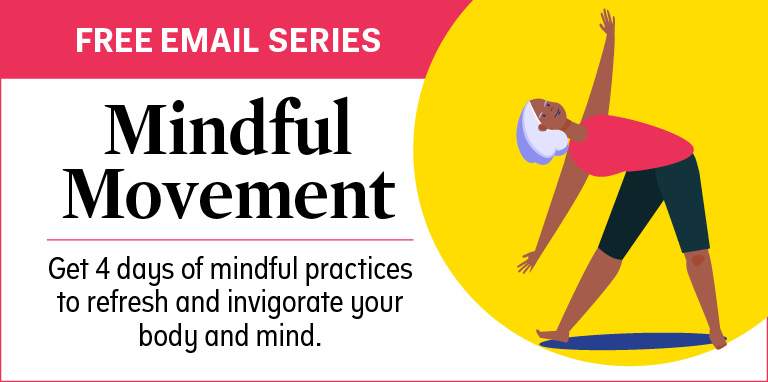

Mindful Walking Meditation
Walking meditation can be a formal practice, like watching the breath. Or it can be informal, bringing awareness to this everyday activity, whenever you need to travel from point A to point B. Walking meditation gives us an opportunity to gather our awareness which so often becomes distracted or even stuck when the mind is left to its own devices. Whether moving between floors of a building, on a city street, or in the woods, it is an opportunity to guide ourselves out of the distracted autopilot we live in throughout so much of our day.
Distance: How Far Should I Walk?
It is best to minimize opportunities for self-distraction. The route you choose to walk doesn’t have to be long. You can even walk on a lane: Ten paces one way, ten paces the other way would be fine. In any event, it is not a sightseeing tour of your environment. You keep your eyes soft and the gaze out in front of you.
Speed: How Fast Should I Walk?
Walking meditation can be practiced at any number of different speeds, and that gives it lots of applications in daily living. In fact, we can easily go from mindful walking to mindful running, a wonderful practice in its own right. There, of course, we abandon the lane, as we can certainly go for long-distance and faster formal walks.
How to Get Started with Mindful Walking
1. Basic Walking Meditation
A basic walking meditation is pretty simple. All you need to do is notice yourself walking as you walk, making your body sensations the anchor of the meditation. To break out of the autopilot we are often in, you might ask yourself, “How do I know I am walking?” and then check in with your senses.
It also may help to bring awareness to certain aspects of walking. For example, you can bring mindfulness to your body as you notice the sensation of your feet on the ground or the movement of your muscles, especially as you encounter different surfaces beneath you. Notice not just what your legs are doing, but also your arms, torso, spine, and head as you walk. You might be able to detect subtle shifts in your pulse, body temperature, or breathing rate before, during, and after you begin moving. You can also focus on the gentle rocking motion of your weight shifting.
Sometimes in sitting practice we use our breath as our anchor and focus on the point between the in-breath and the out-breath, where there is a moment of stillness. Likewise, in walking practice, we can notice the points of stillness where the right step becomes the left step and the left step becomes the right step.
2. Adding Words or Phrases
One simple way to focus your attention is to bring words or phrases to your steps. For one, you can count in rhythm with your steps. Whenever your mind wanders off and you lose count, simply notice where your mind has wandered, and return the count to one again. The key is to do this without judging yourself, and your wandering mind.
It may also help to have something to say along with the movements. You can, for example, say thank you and send gratitude or compassion to your feet and body as you move—a practice from Christopher Germer and Kristin Neff’s program Mindful Self-Compassion. Or, you can quietly or internally repeat reminder phrases to yourself.
You might enjoy repeating the following phrases, suggested by mindfulness teacher Thich Nhat Hanh, with each step:
I have arrived, I am home, in the here, in the now.
Or these phrases, saying for each footstep:
Nowhere to go. Nothing to do. No one to be.
Experiment with any or all of these on your next walk, or come up with your own phrases that resonate for you next time you are out.
3. Sensory Walking
This adaptation for the walking meditation is simple, and just involves really tuning in to our five senses as we move through space. As we get into the moment with our senses, we can really savor the precious moments we do have to be outside and moving, and all that is around us. Our senses keep us grounded in the moment while our thoughts drift to the past or future.
- First, walk while keeping your eyes still and watching the view change as shapes and objects shift in and out of your line of vision.
- Next, focus just on the soles of your feet, aware of different sensations there as the surface changes.
- Then, focus on sounds. Those of your own footsteps, as well as the changing sounds in the world around you as you move.
- Lastly, focus on smells and tastes in the air, and how they change depending on where you are.
4. Body Awareness Walking
As you walk, you can try focusing your awareness on parts of the body, almost like a body scan in motion.
- As you walk, begin by just resting your awareness in your feet, bringing attention to the soles of your feet.
- After about twenty steps, or maybe one block or 5 minutes, shift your awareness to your ankles and calves.
- After a few minutes of your attention there, just rest attention on the bending of your knees.
- Then focus your awareness on the sensations and movement of your hips.
- After some time focused on your hips, shift awareness to your hands and arms, falling naturally or swinging at your sides.
- You might then shift to awareness of sensations in your torso, including inside your body with your heart and lungs, maybe seeing if they’ve changed.
- After a few moments of attention in your torso, turn your attention to your neck and shoulders.
- Lastly, notice your head as it shifts and moves slightly up and down with each footstep.
Continue to scan your body as you walk, noting how sensations change over the course of your walk.
5. Appreciative Walking
Bringing attention to the beauty of our surroundings is another way to bring deliberate awareness to walking, and to actually shift our perception of the world out of the “negativity bias” or inherent pessimism wired into us, toward the positive and beautiful. Various experiments have found that focusing on the beauty around us as we walk tends to have a lasting effect on our mood long after we rest, similar to the way other gratitude and appreciation practices work.
This research is the inspiration for another walking practice: to simply notice the beauty in the world around us as we walk. It may be a tree beginning to blossom, a particularly beautiful shaft of light, a house or car painted a favorite color. On your walk, make a regular practice of noticing one positive thing—something beautiful, something funny, or perhaps even an act of kindness—along the way. Note these to yourself in a journal or share them with family when you return, or share with others online.
You might also, if you take the same route each day, choose to focus on the changes that you encounter. Notice each day as the seasons gradually change, how the sights, sensations and even smells and sounds also change. What’s one new thing that you find, each day on your walk? How about at different times of day, or weekends compared to weekdays?
6. Observational Walking
You can also bring awareness to your own emotional experience of walking. Notice your emotional reactions to everything (and everyone) around you, especially as people and things get close to your personal space. This might bring up small feelings of self-consciousness as you pass others, or a slight pleasure when you step into sunshine, followed by a slight dread as a small hill approaches.
The inverse way to explore our emotions is by noticing how our emotions affect our walking and observations, and vice versa. How does your emotional state change your movement, what you see, or how you respond, depending on whether you are happy or sad, calm or anxious, frustrated or relaxed?
You can even do this on purpose: Change gears and try walking like you are fearful or anxious. Then walk as if loaded down by shame, or as if you are distracted. Try walking confidently after that, and then shifting back into your own rhythm and gait, if you can still find it. Reflect on all of these, noticing where on the spectrum of moods and emotions your regular pace of walking takes you.
You might notice that how you walked affected how you perceived the environment around you. When you walked with sadness, for example, you likely saw less as your eyes were downcast. Or perhaps you noticed that when you walked with confidence, you actually felt more confident, which you probably did if you know about the research of Amy Cuddy and the science of “power poses.”
Guided Walking Meditations
A 10-Minute Daily Walking Meditation
A Daily Walking Practice—Mark Bertin
1. As you begin, walk at a natural pace. Place your hands wherever comfortable: on your belly, behind your back, or at your sides.
- If you find it useful, you can count steps up to 10, and then start back at one again. If you’re in a small space, as you reach ten, pause, and with intention, choose a moment to turn around.
- With each step, pay attention to the lifting and falling of your foot. Notice movement in your legs and the rest of your body. Notice any shifting of your body from side to side.
- Whatever else captures your attention, come back to the sensation of walking. Your mind will wander, so without frustration, guide it back again as many times as you need.
- Particularly outdoors, maintain a larger sense of the environment around you, taking it all in, staying safe and aware.
2. Now for a few minutes, expand your attention to sounds. Whether you’re indoors, in the woods, or in a city, pay attention to sounds without labeling or naming, or getting caught up in whether you find them pleasant or unpleasant. Notice sounds as nothing more or less than sound.
3. Shift your awareness to your sense of smell. Again, simply notice. Don’t push or force yourself to feel anything at all, just bring attention to the sense of smell, whatever you discover.
4. Now, move to vision: colors and objects and whatever else you see. Patiently coming back each time something grabs your attention, or even if something needs addressing, like avoiding an obstacle. Staying natural, not overly rigid, not daydreaming and drifting, but with sustained awareness.
5. Keep this open awareness of everything around you, wherever you are. Nothing to do, nothing to fix, nothing to change. Fully aware, and walking.
6. In the last moments, come back to awareness of the physical sensations of walking, wherever else your mind found itself throughout the practice. Notice your feet again touching the ground. Notice again the movements in your body with each step.
When you’re ready to end your walking meditation, stand still for a moment again. Pausing, choose a moment to end the practice. As you finish, consider how you might bring this kind of awareness into the rest of your day.
A 10-Minute Guided Walking Meditation to Savor the Day
A Guided Walking Practice—Jon Kabat-Zinn
1. Find a lane to practice in so that you can walk back and forth in a place that’s relatively peaceful and in which you will not be disturbed or even observed. The lane doesn’t have to be very long since you’re not going anywhere anyway, just long enough to take 10 or 15 steps or so, then pause. Stand and breathe for as long as you like, then turn and go back in the opposite direction, to the other end of the lane, where you can pause again, stand and breathe. Then, when you’re ready, turn once more, and continue with the walking step by step, moment by moment.
2. You can walk at any speed. We try to be in touch with at least four basic components of each step. There’s the lifting of the foot, moving it, placing it on the ground heel first, and then shifting the weight of the body onto the forward leg as the back heel lifts while the toes of that foot remain touching the floor or the ground.
3. The cycle continues as we now lift the back foot totally off the ground, observe it as it swings forward and lowers, making contact with the ground. Then, our weight shifts onto that foot as the body moves forward. In this way, we walk extremely slowly, just feeling what is involved in walking, moment by moment, and step by step. As for the hands and arms, you can clasp your hands behind your back, or in front of you, or just let them hang at your side. Whatever feels most comfortable and most natural.
4. We can certainly put our mind in our feet and feel them make contact with the floor or the earth, but there’s no need to look down at your feet. They know full well where they are. That is part of our body’s wondrous sense of mindful movement and location. The walking should be slow, but natural. It’s not about walking in a stylized or exaggerated way, it’s merely walking and knowing that you’re walking. You can walk with awareness of the feet, kissing the earth with every step and sensing that the earth is kissing right back.
5. You can sense the air around the body. If there’s a breeze on the skin, you can bring awareness to any and all parts of the soundscape, the bodyscape, the breathscape, the mindscape, the nowscape. All of this is unfolding in any and every moment, and with every step.
6. You can even practice loving-kindness in the walking by evoking one or more people to whom you would like to direct loving-kindness with each step. You could go through your whole family over, and over again, calling to mind one person per step as you walk back and forth, or bring other people to mind, including yourself.
A Guided Walking Meditation to Connect with Your Senses
Connect with Your Senses—Elaine Smookler
1. Choose a foot to start with. Pick it up, move it through space, and gently place it on the ground, feeling the sensations of each part of this process from heel to toe. So, picking the foot up, making a choice, picking a foot up, lifting it, moving it through space, feeling it touching down from heel to toe.
2. Walk with intention. We’re so used to walking in what we call automatic pilot, basically being tuned out and just letting the body go. You may notice that this feels a little strange to be so intentional about walking. That’s okay. This intention that you’re bringing is a way for you to reconnect with the present moment and what you’re feeling right now.
3. Let yourself notice. Notice as much as you can about the feel of picking your foot up, moving through space, and gently placing it down. I get most of us are so used to walking, when we first bring our attention to it, we might even feel a little wobbly. It’s okay: this is normal, and part of what it feels like to wake up and actively notice the details of what we are doing.
4. Focus your attention. Focus on the feeling of your feet making contact with the ground right now. Can you notice a difference between thinking about your feet and feeling them making contact with the floor or the earth? Can you let yourself experience what it’s like to be grounded and connected as you make a conscious choice to be present for this walk?
5. Feel your surroundings. If you’ve chosen to walk outside, allow yourself to feel the impact of the air on your skin. What do you notice? Is it warm or cool? Is the air damp or dry? Allow yourself to feel it.
6. Notice when thoughts take over. You may notice how quickly your attention is drawn to your thoughts, whether it’s thoughts of your day, list making, maybe you’re running an old conversation or story over and over in your mind. Once you notice your thoughts trying to take over your walk, you may also notice that being lost in thought makes it more difficult to connect with your senses. You probably will notice that you find it harder to hear what’s going on in your environment, harder to smell anything, or taste anything. Thoughts are that powerful. So, when you know the thoughts are pulling you away, just notice that this is what’s happening, smile, and then you can gently and kindly choose to redirect your attention back to your felt senses and even more particularly, back to the feeling of your feet walking. Come back to this experience of the senses and the feet over and over throughout your walk.
7. Let yourself experience your surroundings. What do you notice about the weather? Do you have an opinion about it? What happens if you just experience that weather is here, noticing the qualities of the weather, and how you’re experiencing it on the skin or in the body? What happens when you let yourself notice the sounds around you? What do you notice about the smells around you? Can you experience these sensory qualities as the symphony of the world?
The smell of the world: noticing pungent, acrid, sweet, sour, fresh, earthy. Maybe you can notice sounds as high-pitched, low hums, loud, or soft. How much can you allow yourself to take in the world in the minutest detail as your senses experience what’s here, without adding the layer of judgment on it about how you feel about it? Just for now, see what you’re able to do as you take in the raw data of the world around you—experience it in this morning walk.
8. Pause now and then. Another way you might heighten the sensory experience of this walk is, every once in a while, stop right in your tracks if you’re able and it’s appropriate, and notice in a very specific way what it feels like to be grounded as you feel your feet making contact with the earth or the floor. Maybe take a moment to choose a particular thing to experience through the eyes, focusing on color, shape, texture.
Let your nose have a big sniff in and intentionally smell the air. Redirect your attention to your ears and hear the world right now. Can you hold everything you’re noticing lightly, and just let it be part of your environment while you experience it? You don’t have to judge it, or change it, or do anything about it. Just be here for you right now and then when you’re ready, make a choice to select which foot you’ll begin with and start your walk again.
9. Find your pace. Walking, noticing which foot is moving as you pick it up, move it through space, gently place it down feeling the foot making contact with the earth. Although it might help to begin by practicing going slowly, once you have learned to be present to walking in this new way, there’s no reason you can’t move more quickly. Find whatever pace allows you to stay present while you’re experiencing.
10. Try aimless wandering. You might want to use this morning wake-up walk to take you to work, or any particular destination. But if it feels safe to do so, it can also be wonderful to allow yourself to do an aimless walk. Maybe setting a timer, perhaps 15 minutes, and allowing your feet to take you wherever they want to go, staying present to your ever-changing environment without having a goal as your destination. Noticing what it feels like to reconnect to inner instincts that show up as everything starts to quiet a bit, as you heighten your senses with this morning walk. Noticing over and over as the attention is drawn to other things, particularly thinking.
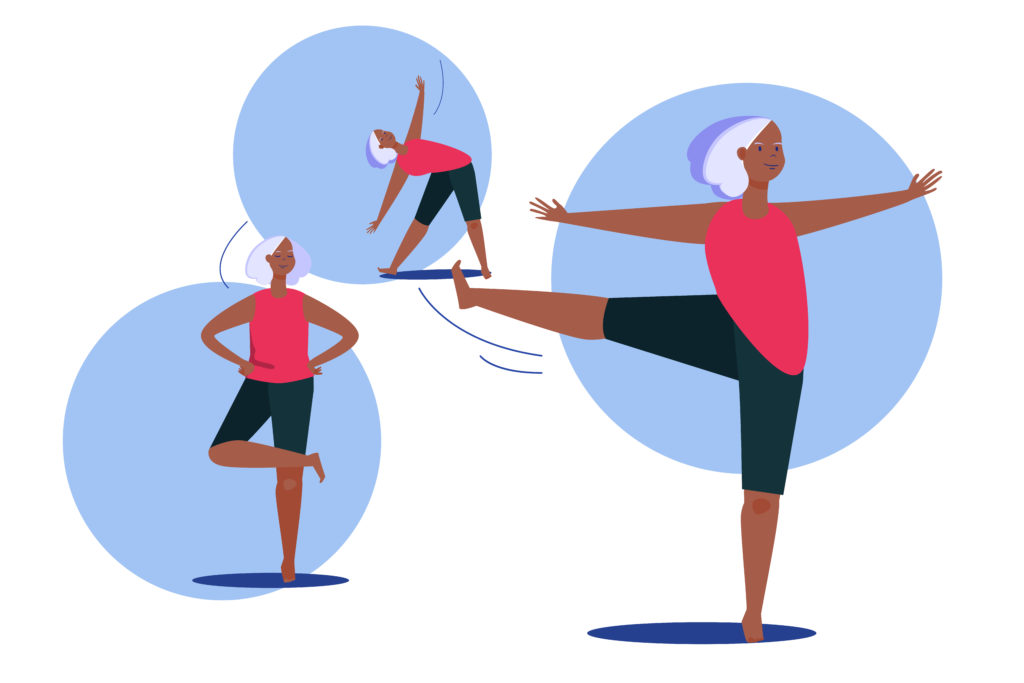
How do Yoga and Mindfulness Work Together?
There are a number of yoga poses that will help you with your mindfulness meditation practice. Here are 10 simple yoga exercises to reduce stress, improve well-being, and get you primed for a sitting meditation session—or anytime.
This sequence emphasizes balance: on your hands, hands and knees, and standing on one leg, as well as when moving the spine in all directions—forward, backward, and sideways. It’s great to do whenever you want to cultivate balance and presence in your body and mind. It takes about five minutes, but feel free to repeat the entire sequence or any section as much as you like. As you move through it, notice when your mind strays, and return to the sensation of the breath or any other physical sensation, such as stretching, quivering, or your muscles tiring. That’s how you’ll know when to push and when to back off. It’s particularly useful to do this sequence before meditation practice as it will create the strength, flexibility, and stamina that will support the physical effort required for sitting.
1. Hand Walking Meditation
In a kneeling position, place your right hand on the floor. Then, left hand on the floor. Walk the right hand a little bit forward. Then the left hand.
2. Find Balance on All Fours
Take your time and notice how your weight shifts onto your hands as you move forward. Move around: Shift weight to the right hand and right knee, then to the left, forward and back. Slowly settle into equal weight on all fours.
3. Cow Pose
On an inhaling breath, lift up your seat and your chest, while you simultaneously drop your spine toward the earth and into your belly.
4. Cat Pose
Exhale, reversing this curve. Lift your waist; drop your head and tail. Repeat 3 & 4, moving with the breath, 5-10 times. Go slowly and try to feel every part of your spine as it curves one way and rounds the other way.
5. Standing Up
Step back your right hand, then step back your left hand, and then shift onto your feet and stand up. As always, as your attention strays come back to attending to the physical sensations.
6. Shoulder Rotation
Extend your arms out to the side. Inhale and roll your arms so your palms face up. Exhale and roll arms in, palms back. Begin this action from the shoulders, letting your pinky fingers be the last part to roll up and down.
7. Side Bends
Inhale arms up. Exhale, bend to the right. Inhale up and exhale bend to the left. Pay attention to the movements from side to side, as well as the position of your head.
8. Chair Pose
Inhale arms up and bend your knees into a chair pose—two movements at the same time! Is your mind still in your body? In the room? Gently let it come back.
9. Leg Bends
As you exhale, stand up on your left leg, right leg bent. Return to chair pose and repeat on the other side. Go right and left, 5-10 times.
10. Stand Quietly
Remain still, keeping your eyes open. Notice what you are seeing. Ground yourself in your environment. Feel your feet on the floor. Observe your breath moving. You can repeat this entire sequence. Feel free to do it as often as you like.
4 Yoga Stretches for a Good Night’s Sleep
Many studies have linked yoga with better sleep. Harvard Medical School sleep and circadian health expert professor Sat Bir Singh Khalsa notes that experimental trials have also shown meditative breathing can be a powerful sleep aid.
Khalsa has researched how meditative breathing can help with sleep, insomnia specifically, and he found that it increased sleep time and decreased wake time. The study had its limitations. It used a particular breathing pattern: inhaling for 4 counts, holding for 16, and exhaling for 2, but Khalsa says that he can make a larger recommendation. Slow, mindful breathing at around 3–6 breaths per minute—normal is 15–20—could be effective for falling asleep. “Anything that slows down the breathing rate will help with decreasing arousal,” he says. And since most mindful movement and yoga poses are done with some form of slow breathing in this range, “putting two and two together, it makes sense,” he says.
And as Khalsa adds, there’s no reason to wait for double-blind studies. The fundamentals for any bedtime routine are consistent. One needs to unwind the mind and the body, so the autonomic nervous system is quieted down and the production of stress hormones, like adrenaline and cortisol, decrease. The slowdown also needs a certain time investment. “While there isn’t a magic combination of poses, doing yoga certainly falls into those parameters.” It’s gentle. It’s relaxing. And, most especially, it’s lying down, and “You can’t fall asleep standing up,” Khalsa says.
Bottom line: There’s little downside to trying and only positives to gain.
Yoga Stretches to Help You Sleep
Jennifer Reis is a certified yoga therapist, faculty member at Kripalu Center for Health & Yoga, and creator of Divine Sleep Yoga Nidra. She suggests four poses, all done lying down, which can help encourage sleep. Do each for a minimum of five exhalations, having your mouth in an O-shape in order to elongate your breath.
1. Bridge
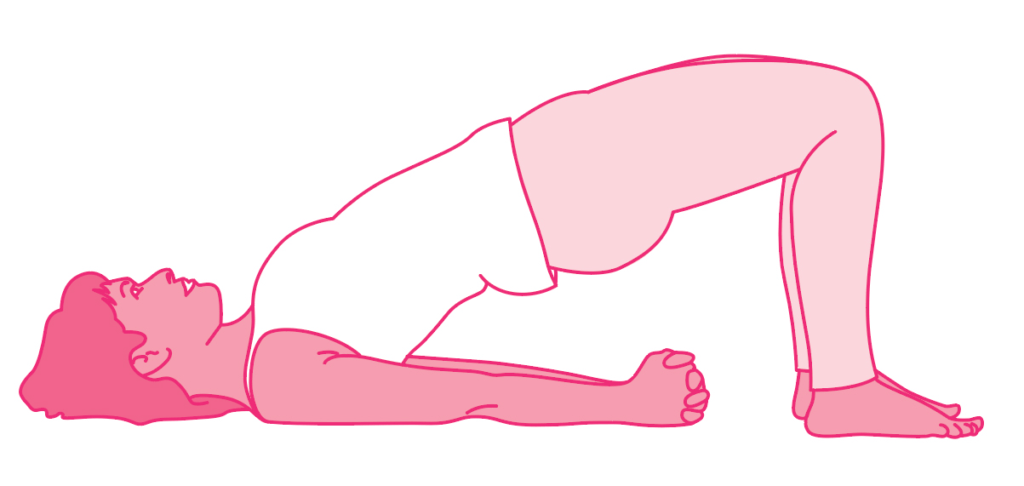
Lie on your back and bend your knees with your feet close together but not touching. With your arms along your sides and palm facing up, press your feet into the floor, reach your tailbone to your knees, and lift your hips into the air, tucking in your pelvis and using a block or cushion for support underneath your lower back if preferred. This position opens up your hips and quads and allows you to observe your belly as you breathe.
2. Supported Fish

Lie on your back with a pillow supporting your shoulder blades. Position your arms out at 45 degrees from your hips with your palms up. You can keep your legs straight or have your knees bent and together with your feet slightly apart. This will help relax your upper-back muscles and stretch your chest.
3. Spinal Twist
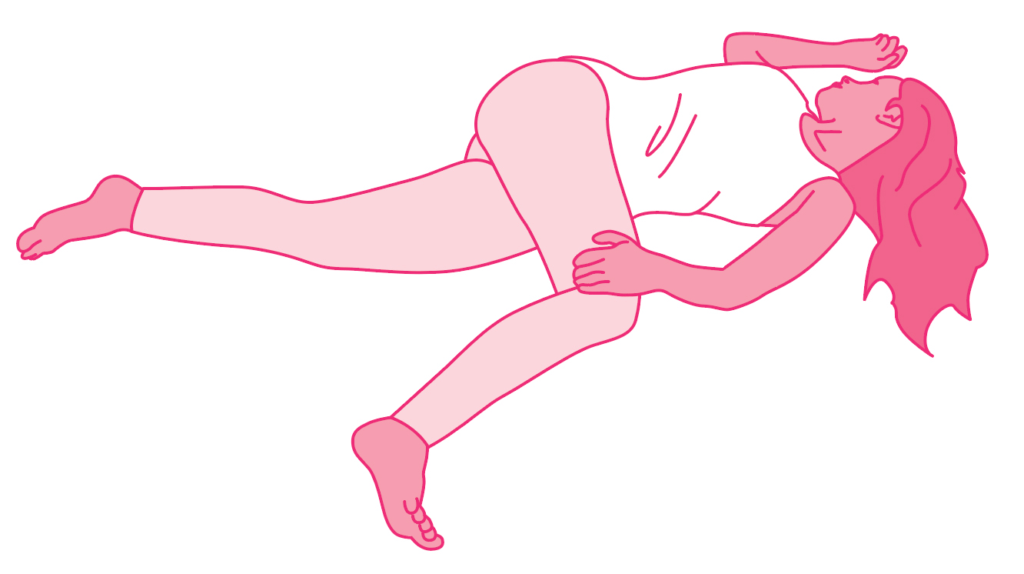
Lie on your back with arms out in a T formation and palms up. Start with bent legs, then bring your right foot onto your left leg wherever it feels comfortable. Gently press your right knee to the left with your left hand, twisting your torso. You may feel a stretch in your shoulder, chest, lower back, hip, or thigh—it will be where you most need it. Return to the center and do the other side.
4. Legs Up the Wall
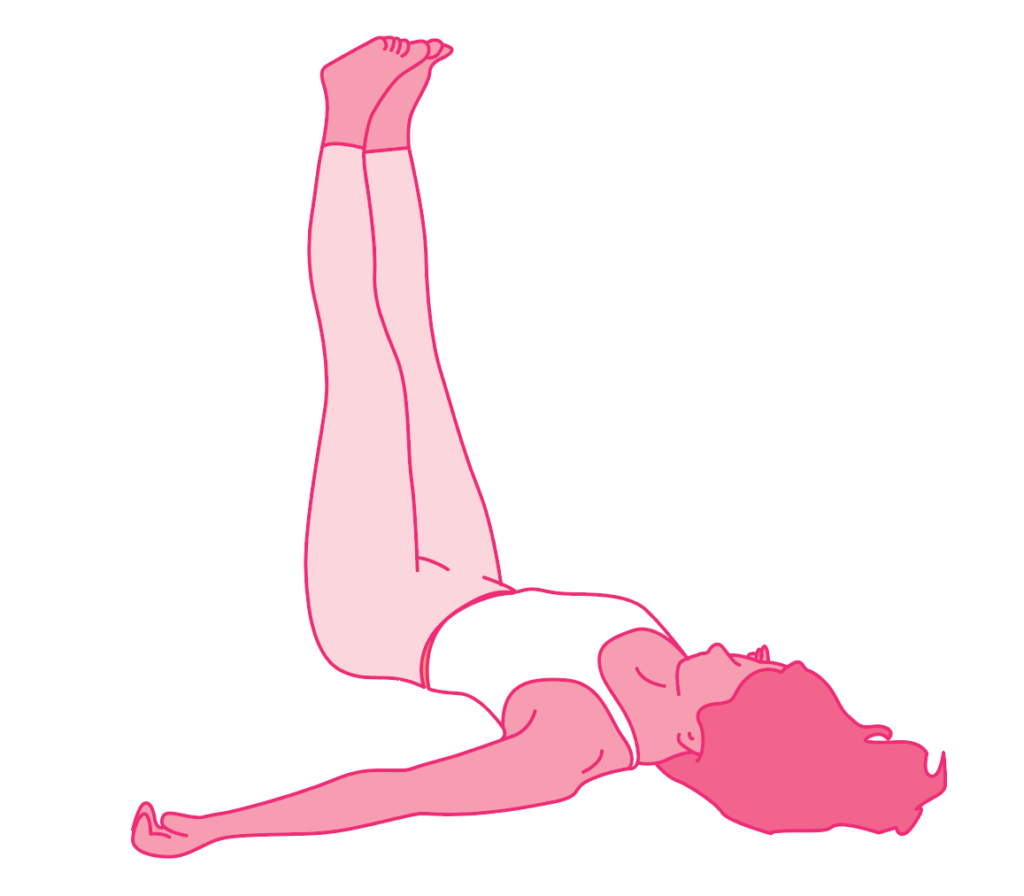
Lie on your back with bent knees and move your buttocks as close to the wall as possible. Bring your legs up the wall, lift up your hips, and put a pillow under your lower back to keep your pelvis off the floor. Keep your feet apart a few inches and relaxed. After a day spent standing or sitting, your legs will feel lighter and your body will feel more balanced overall.
read more
3 Ways to Get Your Workout Off Autopilot
Whether you’re ready to get off the couch or upgrade your exercise routine, these expert-recommended tips will engage your mind while keeping you in tune with your body’s capabilities.
Read More
How Mindfulness Can Boost Your Exercise Habits
Mindfulness teacher Cara Bradley offers practical advice on how mindfulness can help with adding movement to your day.
Read More
Resilience Expert Offers Three Ways to Tap into the Wisdom of the Body
Linda Graham presents a full toolbox of practices to help you meet the chaos of life with awareness, acceptance, and deep knowledge that you have the strength to work with it all.
Read More
The Ultimate Guide to Mindfulness for Sleep
Sufficient sleep heals our bodies and minds, but for many reasons sleep doesn’t always come easily. Mindfulness practices and habits can help us fall asleep and stay asleep. Consult our guide to find tips for meditation, movement, and mindfulness practices to ease into sleep.
Read More
